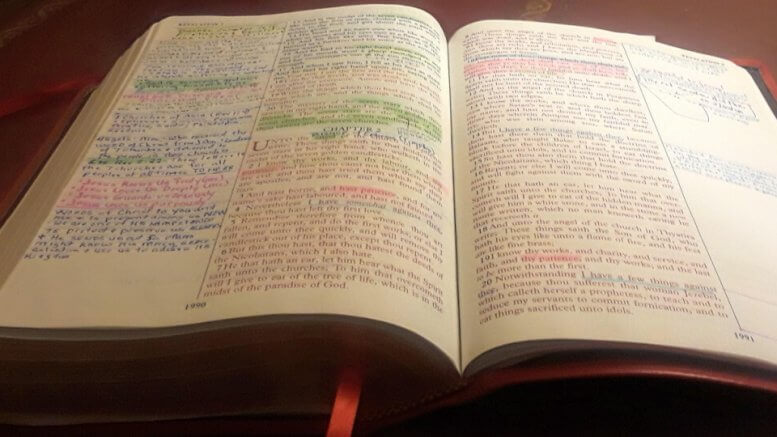Approaching Scripture with the question, ‘What did this mean to the original hearer or reader?’ will get us headed in the right direction.
David G. Hansen PhD | Associates for Biblical Research
During my freshman year of college, a Bible professor said we should put Bible stories into context to find the excitement in them and appreciate their real meaning. I never understood what he meant and was too embarrassed to ask in front of the class…
During my freshman year of college, a Bible professor said we should put Bible stories into context to find the excitement in them and appreciate their real meaning. I never understood what he meant, and was too embarrassed to ask in front of the class. As the years went by, I frequently heard the same axiom, and looked for an explanation. Some sources said context meant examining a Bible passage in relationship to the verses preceding and following the ones I was reading. Others asserted context meant I should be careful not to read something into a Bible story that did not fit the perspective of the complete narrative. To say the least, these definitions, and others I found, were not very helpful in explaining context. Therefore, as I did my Bible reading, I generally ignored context, whatever it meant.
As the years went by, I realized something was seriously wrong with my Bible study. I found it difficult to kindle excitement and, in all honesty, Bible stories and reading became boring. In an effort to make my Bible reading more satisfying, I frequently puzzled over the illusive concept of context. Finding no answer, I continued to interpret and apply Scripture based on my knowledge and life experiences, and looked for answers to puzzling questions in commentaries and books written by people who, I believed, had deeper insights than I.
Then, I went to a seminar in Israel led by a wise teacher who introduced me to his concept of context. During the few weeks I studied under this man, he challenged me to read and comprehend Bible stories as the original hearer or reader would have understood them.
What a revolutionary idea: Read the Bible as would the original recipient! Comprehending context in this manner reformed how I viewed the whole Bible. It has revitalized my excitement of Bible accounts, and led me to deeper insights of both the Old and New Testaments. Examining the Bible accounts in context has revealed meanings transcending the ones I usually read or hear.
But, be forewarned. Although I advocate applying the simple theorem context, anyone who practices this method will quickly find it takes effort. To learn what the stories meant to the original hearer or reader is difficult because we live in a different environment from those who first saw, heard or read about Jesus. We must get out of our comfortable, twenty-first century understanding of culture and life.
To really appreciate the Bible stories of Jesus, we must discover what existence was like in Bible times. To do so requires a basic understanding of Middle East geography and its sub-disciplines (geology, topography, climate, etc.), ancient history, first-century languages, economics, law, and cultural practices. It also helps to have an acquaintance with the many archaeological discoveries being reported every year that illuminate life and religious practices recorded in the Bible.
But, don’t let the difficulty of exploring context dissuade you. In spite of its hurdles, I have come to the conclusion that context is crucially important for a correct understanding of what the biblical authors were telling their audiences. Before I realized the significance of context, I would have asked why everyday Christians should do such arduous research. Surely, scholarly investigation of this type is the provenance of college professors, pastors, and other academics.
Doug Greenwold,2 a proponent for contextual sudy, gives us the following reason:
All too often in our church lifetime, we end up being given many theological and doctrinal factual ornaments, but seldom are we shown the tree upon which to hang them. It’s as if we have been handed dozens of pieces to a puzzle, but have never seen what the finished picture on the top of the puzzle box looks like.
I admit, I frequently mishandled Scripture before I began to recognize the value of context in Bible study. I only saw the ‘pieces’ of the puzzle and tried to fit them into what I thought the top of the box should look like. Doing so resulted in making a ‘picture’ based on my cultural experiences. It was hurtful to the Message and harmful to students and the readers of my articles.
Bible authors, especially the New Testament writers, were literate in Old Testament history, languages, general history, etc., and expected those who read their writings to understand the setting of the stories. Most Christians will profess they have some familiarity with New Testament culture and life. But our education is usually superficial and comes from movies, television documentaries, novels, and commentaries. Even though we may believe we understand New Testament times, almost all of us will agree that the Old Testament is a little-discussed portion of Scripture to most lay people.
Now, thousands of years later, we think we can imagine what the Bible stories may have meant, but in fact, we have no real basis for our understanding. It is hard to put ourselves in the original hearers’ sandals – those people who lived thousands of years ago. If we are brutally honest, we will admit we have limited knowledge of their climate, geology, politics, languages, history, legalisms, religions, and daily life, and as well as what archaeologists have learned about the Bible world.
A problem, it seems to me, is commentaries attempt to investigate context without explaining why they are doing it. The beautiful simplicity of my seminar teacher’s explanation, that we should discover what the original writer’s message meant or what the original listener heard, resolves the problem. When we don’t try to get to the writer’s intentions, our twenty-first century contextual understanding of subjects can and will lead us to conclusions other than those intended by the original authors.
But, you can’t become a contextual scholar overnight. We’re busy people, and unable to simply drop everything to become literate in Bible context. Still, I believe serious readers of the Bible – those who desire to learn what the New Testament writers really wanted their readers to know about Jesus, or understand the accounts in the Old Testament – should recognize they must investigate the environment in which the authors wrote.
Approaching Scripture with the question, ‘What did this mean to the original hearer or reader?’ will get us headed in the right direction. To answer the question, we need to broaden our reading and find resources that will assist us to know how people in antiquity lived and worked. My thesis is simply this: I don’t believe the New Testament writers, or others before them, selected stories and accounts of Jesus so we could interpret them based on our lifestyle two thousand years later. Surely, some of those early writers would be shocked to learn how we have misconstrued what they wrote. I have found it helpful to question why, of the many things that Jesus did on Earth, did the writer select the story he did. Even John admitted, ‘Jesus did many other things as well. If every one of them were written down, I suppose that even the whole world would not have room for the books that would be written’ (Jn 21:25).
In New Testament times, too much information might account for why Bible authors excluded certain stories and others did not. But, overload of information was probably not the primary reason. Consider, instead, that each of them was writing about Jesus for varied audiences and for different motives. The operative question for them was how the stories confirmed – for their specific reader – that Jesus was the Messiah, God’s Son, the One who gave His life so we can be eternally reconciled with God. In other words, how did the stories affirm and explain Jesus’ message of salvation?
That seminar leader years ago in Israel impressed on me how I needed to change what I read, taught, and studied in the Bible. Instead of wearing twenty-first century glasses when I read the stories, with all my Western prejudices and cultural biases, I now know that I need to go back in time to the first century, or even before. When I do so, I discover important meanings in Bible events that greatly deepen my appreciation of the totality of the Bible story, from Genesis to Revelation.
Now, when I read the Bible, I try to go back to the time of the writer. I attempt to place myself in the story, and I wonder: what would I…? By practicing context, it is my prayer you will see many well-known stories from an excitingly new point-of-view. Hopefully, each will refresh your curiosity about the Bible, and encourage you to know more of the intentions of the original writers. If you accept the challenge of seeking context, I can guarantee that you will be rewarded with faithful and accurate interpretation of the stories.
A final thought. Knowing what life was like in Bible times will not change what Jesus has done. What it will do, however, is clarify the truth of the stories of how God informed us that He was going to send the Rescuer, Jesus. God told us this using the life and times of real men and real women in the Old and New Testaments. Their stories began in Genesis and continued until after Jesus was resurrected. The Bible is a narrative of God’s faithful promises. The evidence for its truth is the stories of the Bible. The goal of contextual study is to know the truthful stories as their authors, and God, intended them: as a revelation of His Son. They are not to be interpreted in the light of our contemporary culture.
SOURCE: ASSOCIATES FOR BIBLICAL RESEARCH
Notes
1 Portions of this article appeared in David G. Hansen, In Their Sandals (Xulon, 2007).
2 Doug Greenwold, Zechariah & Elizabeth (Rockville, MD: Bible-in-Context Ministries, 2004), p.73.





